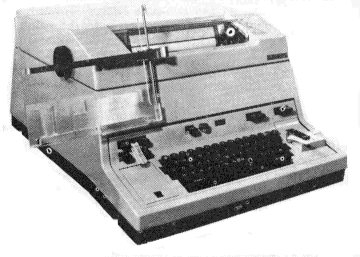

The members of one Brooklyn hacker space have used their Teletype Model 15 as a gaming console and, somewhat ironically, as a printer for their Twitter feed. Airlines continue to use teletype technology for some communications, and groups of teletype enthusiasts have emerged to refurbish the machines and communicate over Radio Teletype (RTTY). But in a few circles, appreciation for the machines has grown. Hundreds of thousands of teletypes are currently gathering dust in basements and junkyards across the world. It was the rise of fax machines, personal computers, and ink jet printers that nudged the teletype into obsolescence. Some of the earliest computers used teletypes as a programming interface and the machine’s influence is still evident in the structure of modern coding. Within decades, the teletype made the world a more connected one, not only sending and disseminating vital information, but changing the way companies and governments processed data.

It was through teletype machines that newsrooms and then the public learned of the allied invasion on D-Day. When World War II started and Morse operators were scarce, teletype machines became an integral component of the communications infrastructure, enabling the coordination of millions of people across the globe. With the teletype, a single individual could feed a pre-typed punch tape through the device, instantly and simultaneously sending a news item to hundreds of newsrooms.
RTTY MACHINE CODE
They had previously sent individual dispatches to their member newspapers via Morse code and messenger boy. In 1914, the Associated Press began using the machines. It was an invention that changed the world. When World War II started and Morse operators were scarce, Teletype machines became an integral component of the communications infrastructure. The devices could instantly transmit their text over hundreds of miles, at a speed and rate that was four times faster than the average telegraph message. And, unlike typewriters, teletypes had the remarkable capacity to connect. Its keyboard interface democratized the transmission of telegraph messages by enabling anyone who could use a typewriter to send a message. The teletype was fast, accurate, and didn’t require the complication of a human mediator. These bits are conveyed over an electrical wire running to the destination unit which then converts the electrical signal back into mechanical movement, translating the sequence of five bits into the proper letter, which it types onto the page with a distinctive clickety-clacking.
RTTY MACHINE SERIES
Pressing a key on the teletype’s keyboard initiates a mechanical action translating the letter into a series of seven bits: a start signal telling the receiving machine to “listen,” then the five bits of code indicating the letter, and an end signal. Their creation is complicated but elegant:

Later version of the Morkrum Printing Telegraph, eventually re-named the Teletype, c. The duo invented the teletype machine as we know it, and founded what would later become the Teletype Corporation. By the time salt magnate Joy Morton and electrical engineer Charles Krum took up the challenge in 1902, the world was ready. History saw automated, printing telegraphs as early as 1848, many with piano-like “key” boards. They might make mistakes.įor decades, inventors endeavored to create a machine that would eliminate the possibility of human error from long-distance communication. They might not have time to accurately transcribe a message before the next came dotting and dashing down the line. They might be bribed to divulge their advanced knowledge on business deals or stocks. But they still had all of the foibles and failures of average people. Telegraph operators were the gatekeepers to communication. In order to send a message, one needed to go through this intermediary who would translate your missive into Morse code and beep it across the wire to another operator who would decode it into text and hand it off to a delivery boy to track down the recipient. Until just a century ago, the most advanced telecommunications system still relied on a human interface: telegraph operators. No postage, no railroads, no messengers needed to send. Type a message on a teletype keyboard, and out it would clatter from a printer-or thousands of printers-across the globe. In the age of the telegraph and Morse code, this machine automated the process of sending written communications, making a vital imprint on how we connect with each other. Never mind that it’s been long forgotten and somewhat neglected in history books. The teletype is a mechanical marvel that dramatically changed telecommunications. The most revolutionary messaging device that you’ve never heard of.


 0 kommentar(er)
0 kommentar(er)
